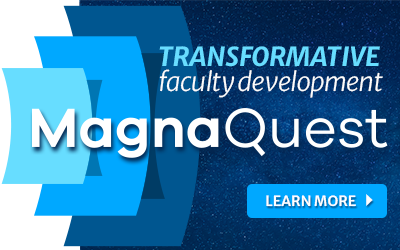What can you do with four minutes?
You can close the report and check the clock, update your to-do list, sort through your mail, or respond to a minor e-mail query. There are many important tasks you can do in four minutes. And if you don’t do them now, you’ll just have to find another four minutes later. Of course, none of this matters if you have plenty of time and too little to do, but most institutions have finite resources and must be deliberate in how they use them. Program assessment presents a special challenge to resource allocation, requiring a similarly deliberate approach.
Importance of program assessment
Program assessment is a critical task in higher education. It is mandated by accrediting bodies and indispensable in the quest to provide high-quality programs that are well received by students, communities, and other key stakeholders. Furthermore, from the finest of arts to the hardest of sciences, one mission of all academic programs is to promote critical evaluation of the field’s products and processes. To fail to apply a similar analysis to our own work would lack integrity.
Program assessment’s place in academia
While program assessment is important, it is not and should not be mistaken for an essential function of academic institutions. While different institutions pursue different missions, none of us exist primarily for the purpose of assessing our own effectiveness. Assessment should be explicitly identified as subservient to our essential functions.
There are three reasons that assessment is a special case in resource allocation:
- For any institution with finite resources, there is an inherent contradiction of purpose in program assessment. Every four minutes spent on assessment is four minutes not spent on the essential functions being assessed. While assessment should help us make our teaching better, too much assessment will make our teaching worse by diverting resources away from the very functions we are assessing.
- The relative newness of the age of accountability in higher education creates urgency within a context of uncertainty over what will be considered acceptable by accrediting bodies. A natural response to the combination of pressure and uncertainty is to err on the side of overperformance, diverting resources away from essential functions in an effort to bolster assessment.
- Though methodologies vary wildly, many academicians have great expertise in critical evaluation. Furthermore, in academia we find a high concentration of people who are constitutionally inclined to strive for the “top grade” on all tasks, regardless of relative priority.
Of course, assessment is important and worth investing in. Ideally, every task will be assigned exactly the right resources in exactly the right quantity at exactly the right time. Because this level of precision is impossible and prohibitively costly to pursue, institutions must choose their errors by selecting which functions to oversupport and which to support minimally. Because of its nonessential nature and inherent contradiction of purpose, assessment should fall into the second category.
Why lean?
Many academicians have virtually no training in resource allocation. Furthermore, academia sometimes lacks the direct feedback mechanisms more apparent in traditional businesses, especially at the department level, where assessment plans are developed.
A few core principles from the Lean Six Sigma model can help departments keep assessment “in its place.” Simply, “lean” means creating more value for customers while using fewer resources. This approach involves identifying all the institution’s tasks and analyzing each from the customer’s perspective. While academia serves many customers (e.g., the future employers, patients, clients, and customers of our students; citizens; community leaders; current professional experts), we will focus here on students and their future employers.
Once customers have been identified, it is important to understand their voice by determining which institutional tasks are of value from their perspective. These value-added activities are defined as tasks for which the customer is willing to pay. However, some nonvalue steps are prerequisites for value-added tasks. Any unnecessary non-value-added tasks are considered waste. Once defined, the tasks can be prioritized. Value-added activities are supported and necessary, but non-value-added tasks are minimized, eliminating waste.
Lean assessment planning
These core principles of Lean Six Sigma may be readily applied to program assessment in academia.
- Assessment planning should be student centered and responsive to the needs of local employers and experts in the field. Students do not care whether our assessment plans amaze our administrators and leave our accreditors in awe, and neither do the people who will hire them. Our customers want very good programs with very good reputations at a cost that makes sense. For institutions with finite resources, highly demanding assessment plans risk counterproductivity by diverting too many resources from essential (value-added) functions.
For example, because many disciplines use student portfolios to assess department effectiveness, an array of sophisticated portfolio management software packages has entered the market. The lean approach asks us to consider whether this methodology would be student centered.
- Assessment planning should be strategic. Every step of every process is evaluated for efficiency and waste. We should be on the lookout for practices that swallow up resources while yielding barely consequential or negative returns. For example, are the costs (i.e., time, energy, money) of purchasing, maintaining, learning, teaching, using, and evaluating the products produced with the portfolio software package justified by the expected gains to program outcomes?
- As a necessary but non-value-added task, assessment should be minimized. Minimizing doesn’t mean that we treat assessment as unimportant. We should articulate a standard that meets the critical objectives of complying with accreditation requirements, improving program quality, and maintaining integrity, but we should accept that standard as “good enough” and go no further. Deliberately suppressing functioning to meet a good enough standard allows more resources to be directed toward essential functions. For example, even if the costs of portfolio management software seem justifiable, can the good enough standard be met through less costly methods?
- Assessment should be put in its place and kept there. The lean approach helps us remember that the more impressive an assessment plan is in terms of the work and commitment it requires, the more likely it is drawing valuable resources away from essential functions. Administrators should take the lead in designing processes for developing, implementing, sharing, and evaluating assessment plans that explicitly encourage departments to avoid misallocating excess resources away from essential functions. We should cultivate a knee-jerk wariness against being dazzled into heavily resourcing nonessential tasks. We should evaluate assessment plans for value, strategy, and minimalism and save the neat stuff for the classroom.
Assessment and beyond
The inherent contradiction of purpose in assessment makes it a low-threat vehicle for introducing lean efficiency principles to people who may have little training (and even less natural interest) in matters of efficient resource allocation. Once understood, the approach may be easily applied to a variety of domains of functioning. In financially challenging times, when academic budgets are tight and faculty are called upon to wear an ever-expanding wardrobe of hats, lean principles may allow departments to prioritize their own processes to manage heavy workloads more effectively and stay student centered. Remember, even four minutes can make a difference.
Kayla Waters is an associate professor, MA coordinator, and cochair of the Human Services Department at Washburn University. Zach Frank is the Physical Therapist Assistant program director at Washburn University.
Reprinted from Academic Leader, 32.7 (2016): 2, 6. © Magna Publications. All rights reserved.



